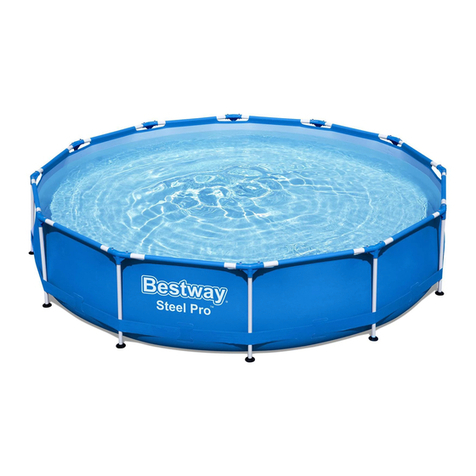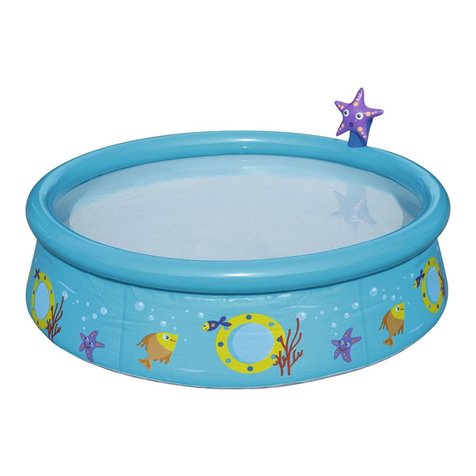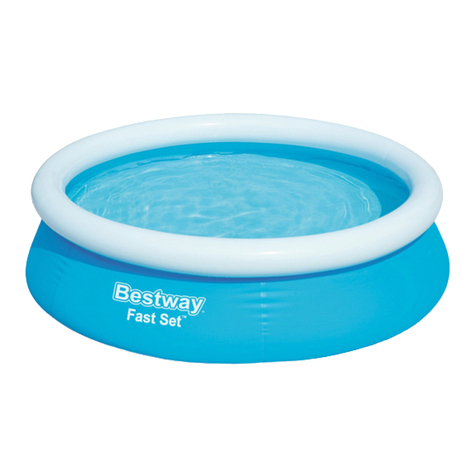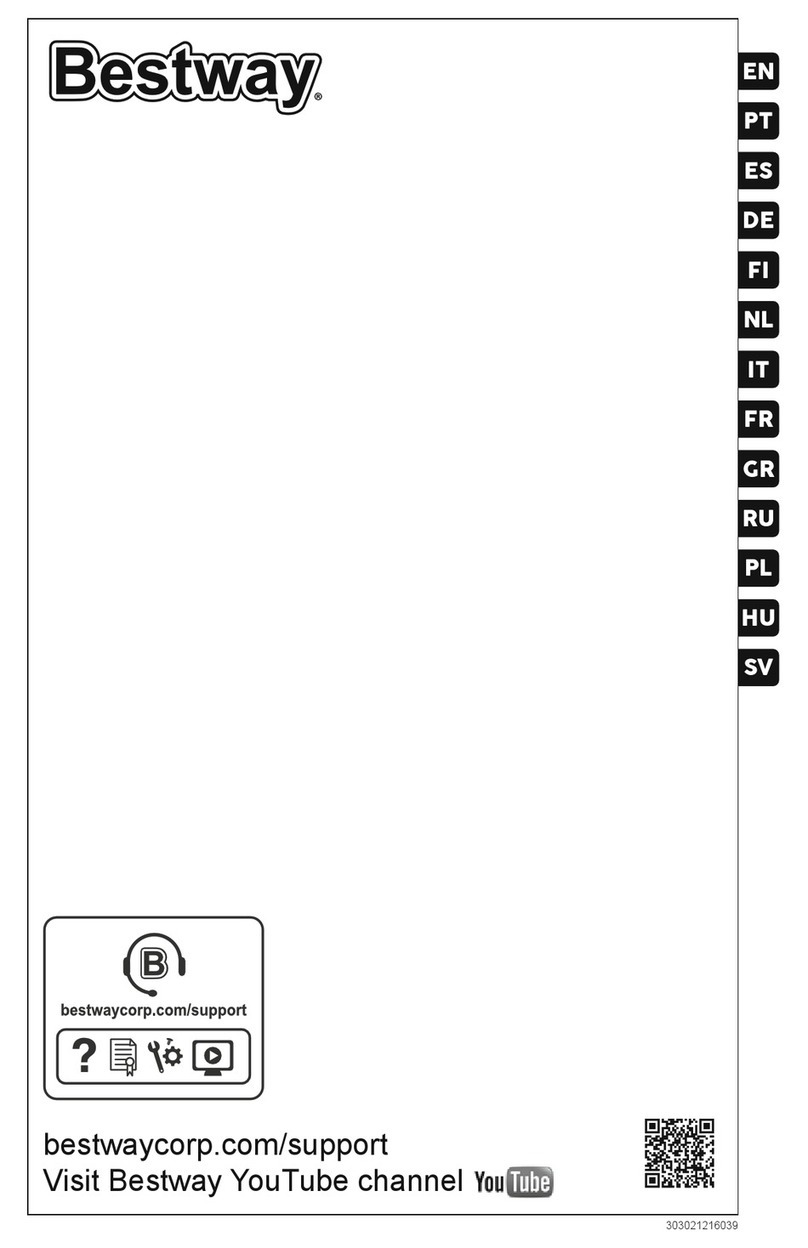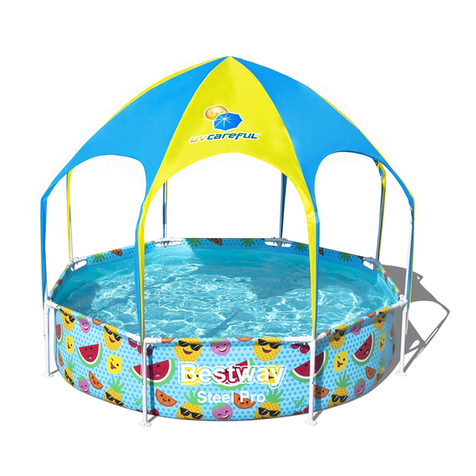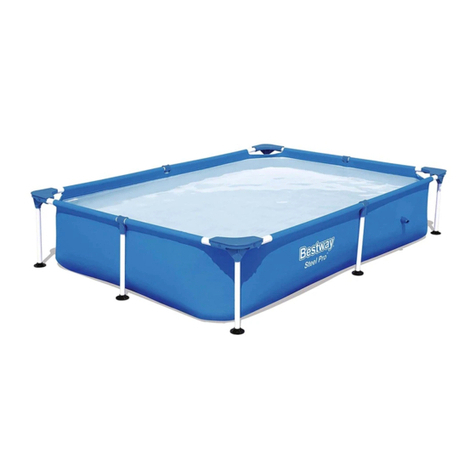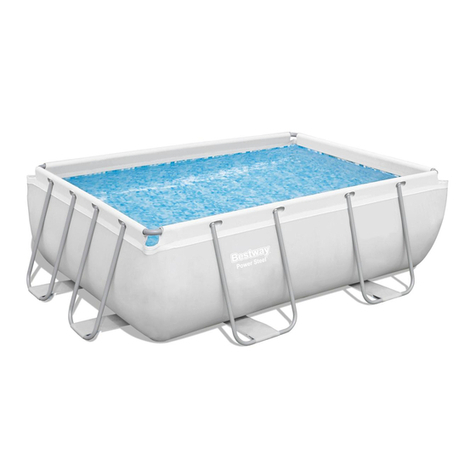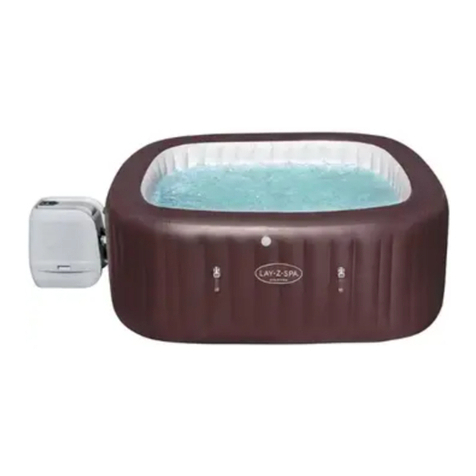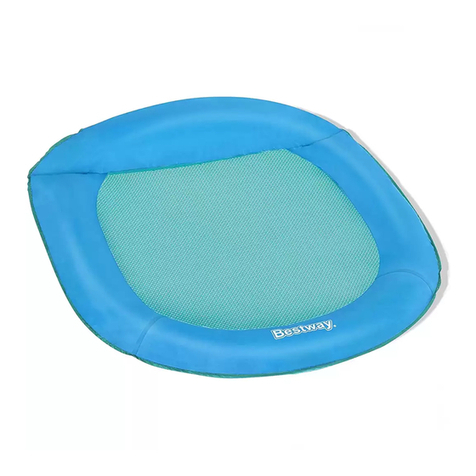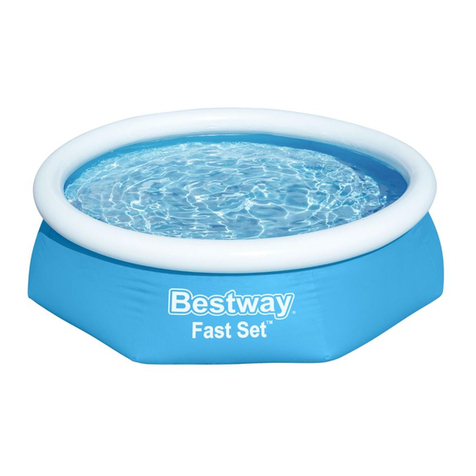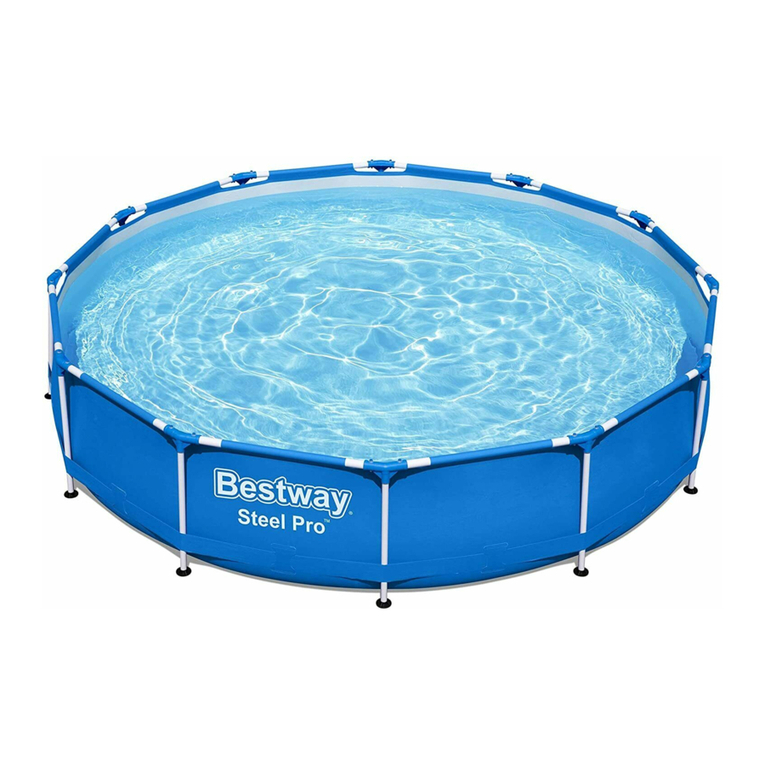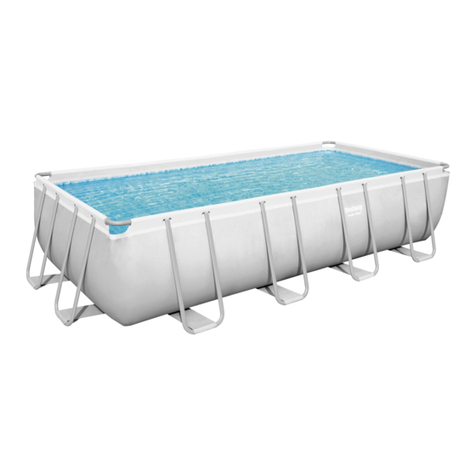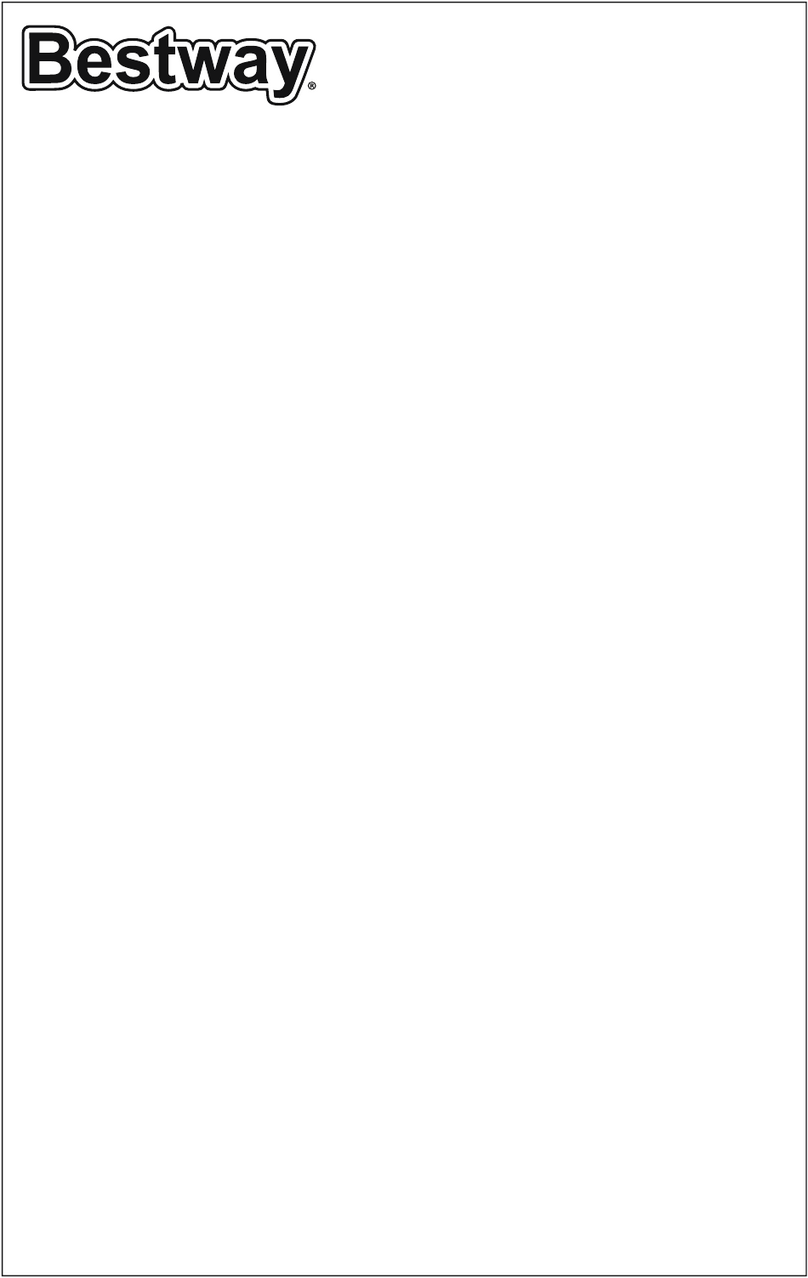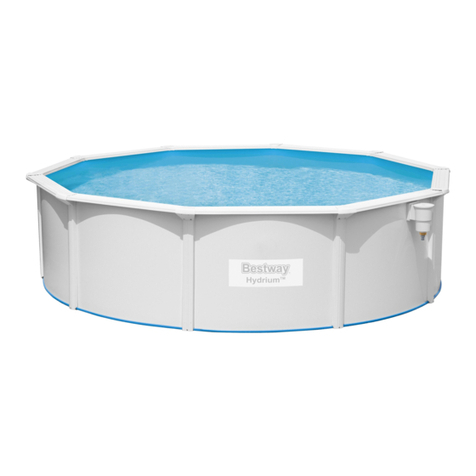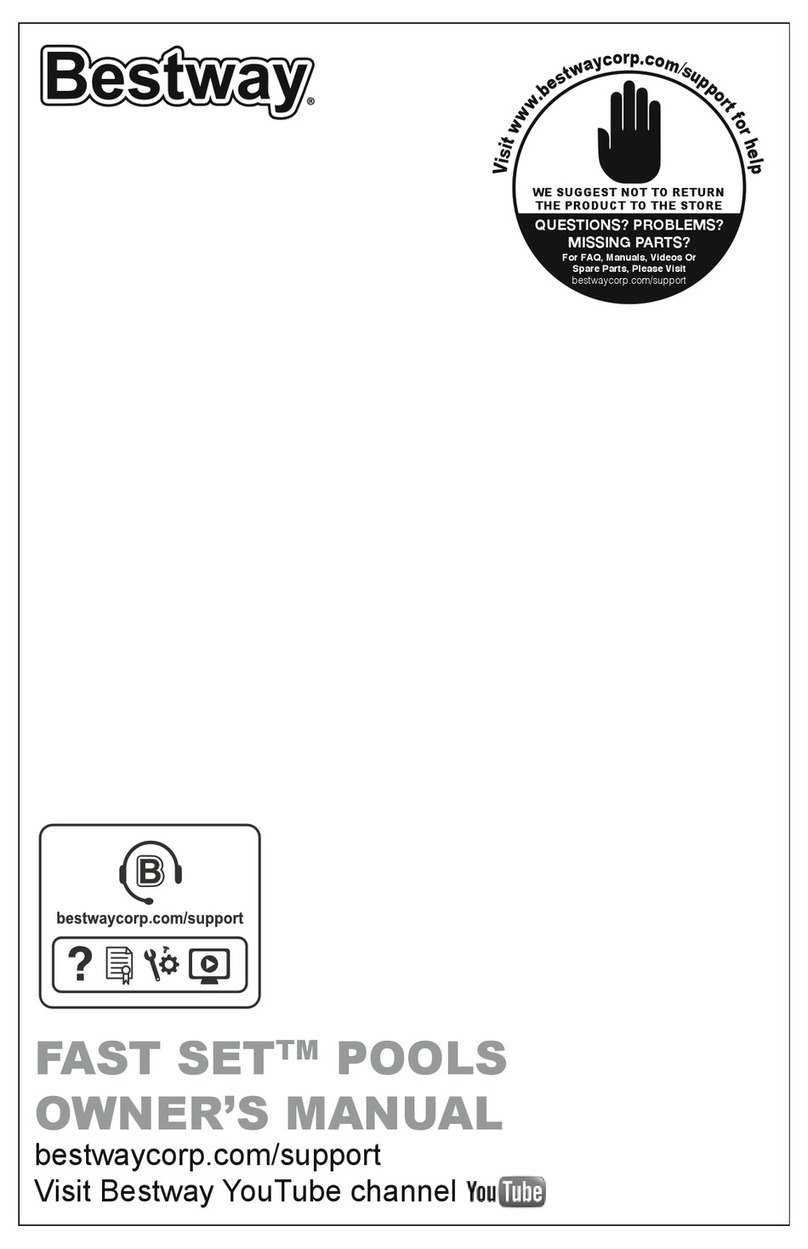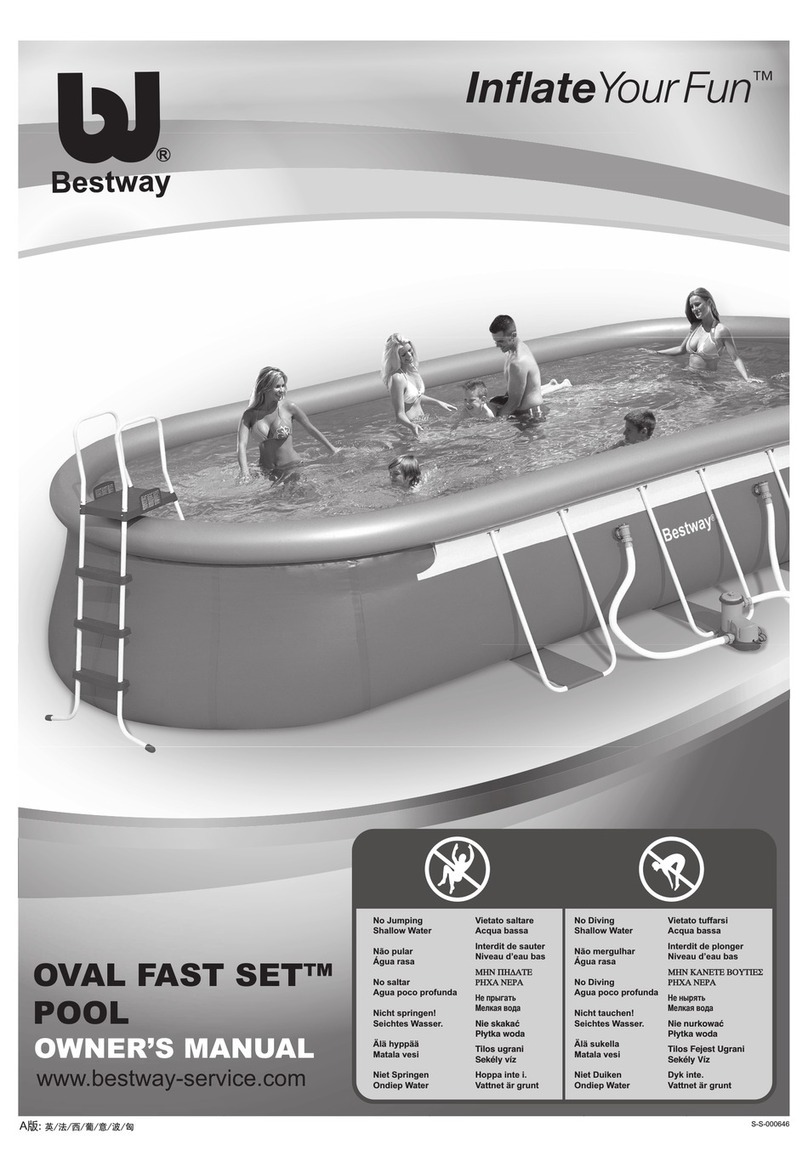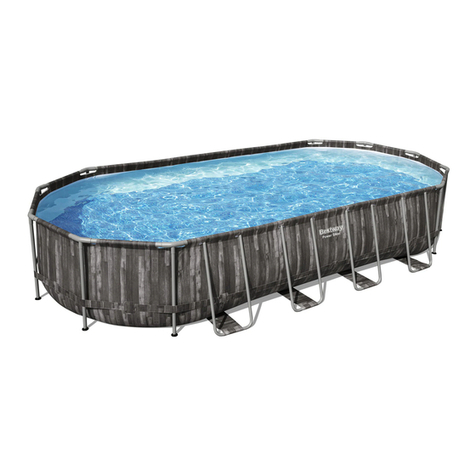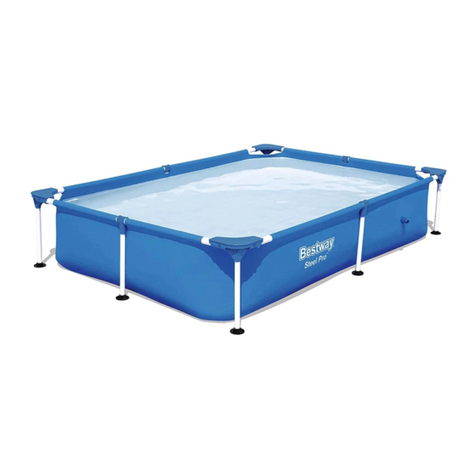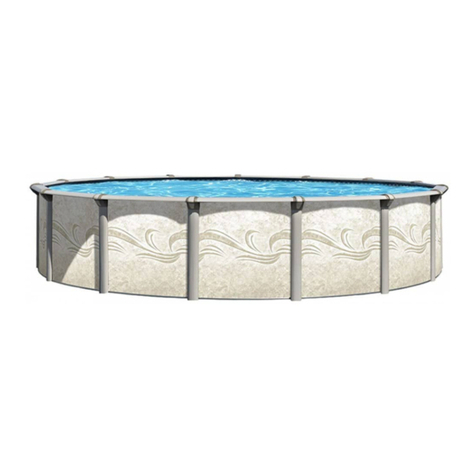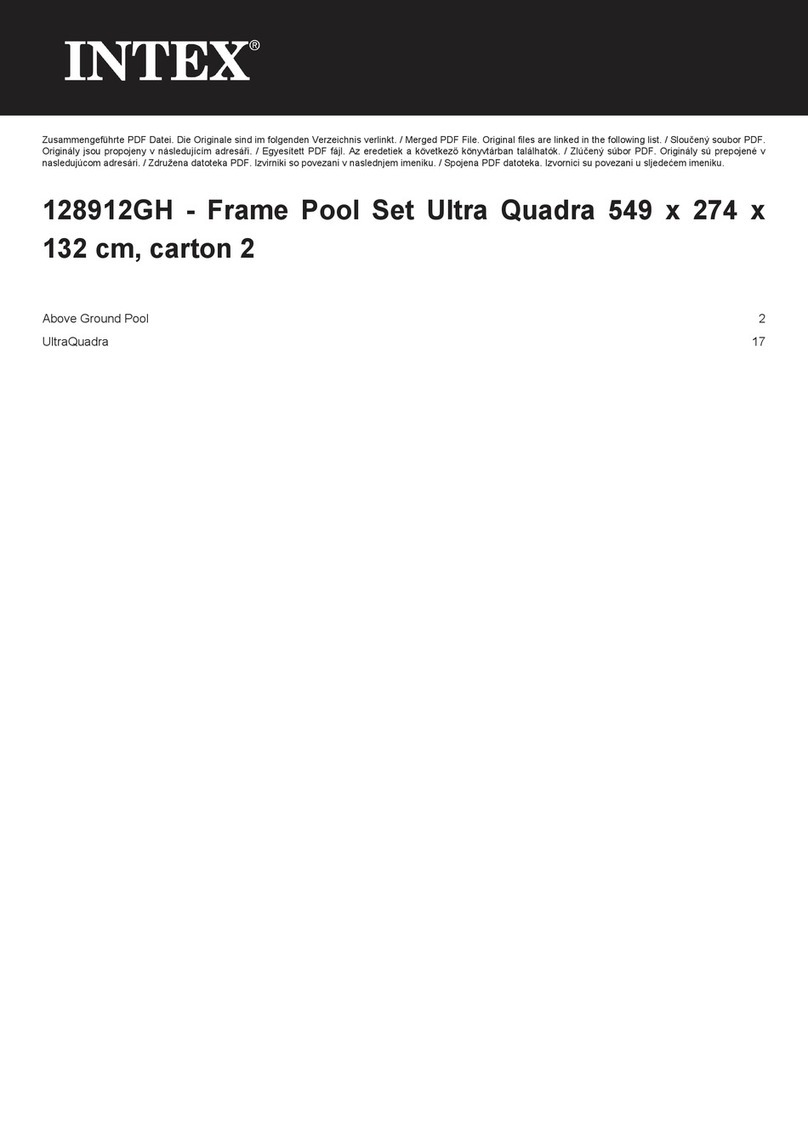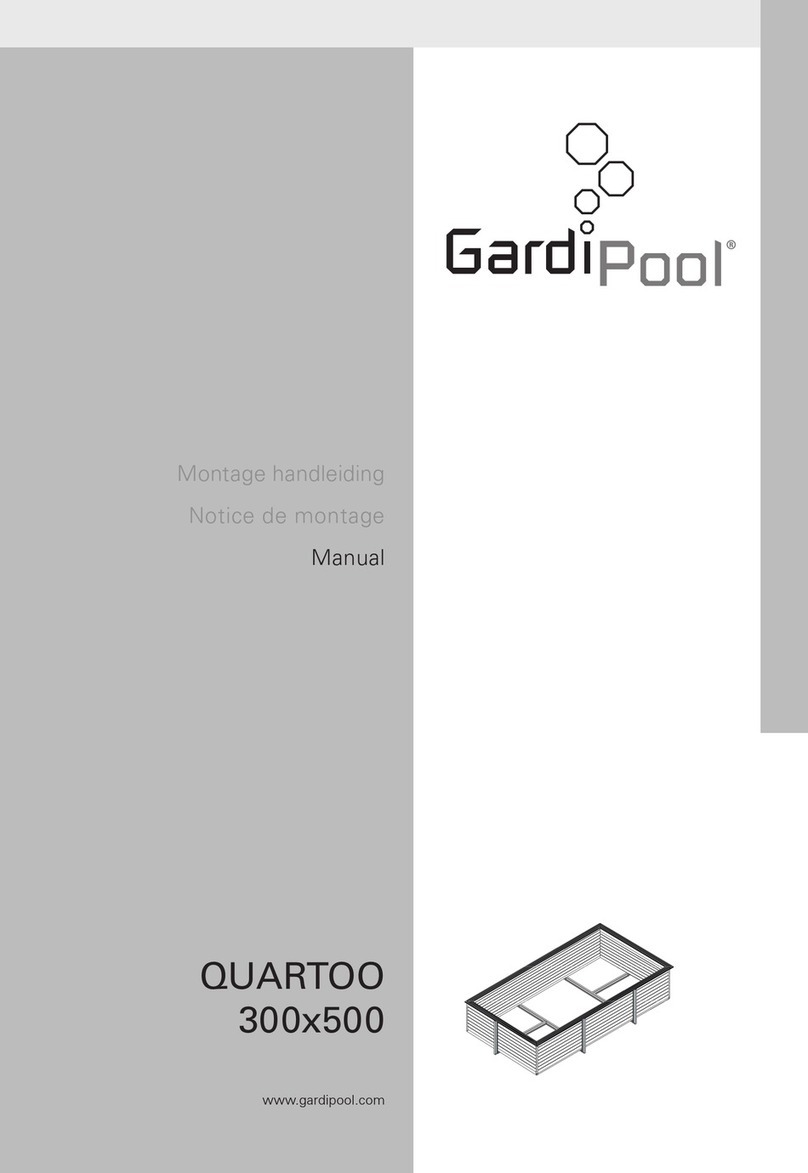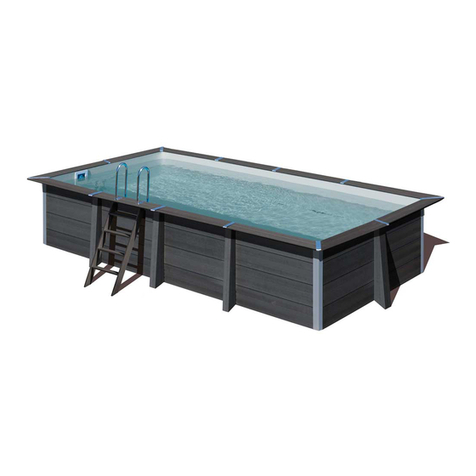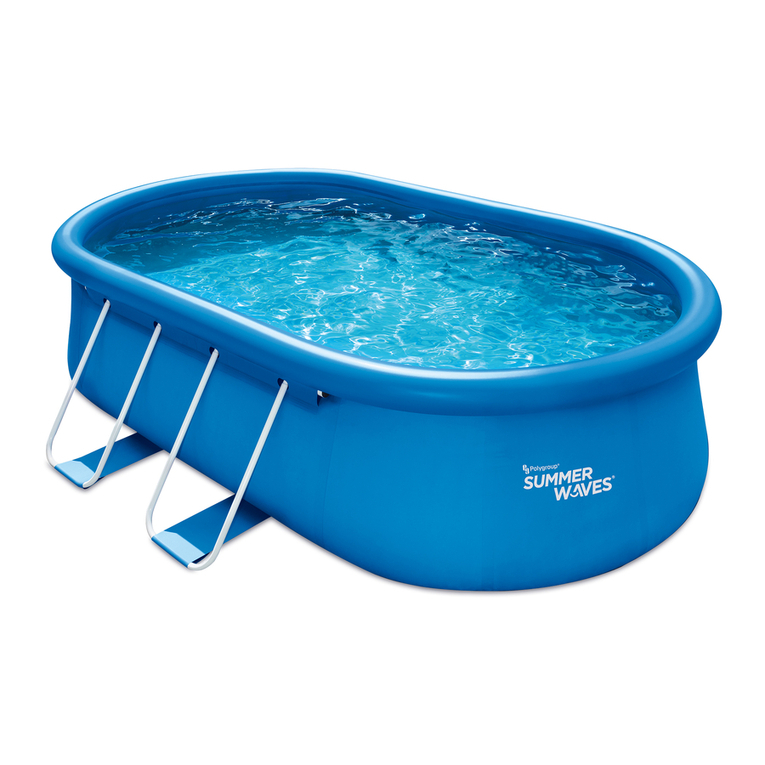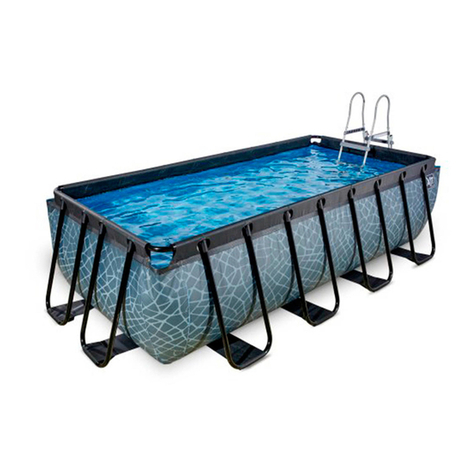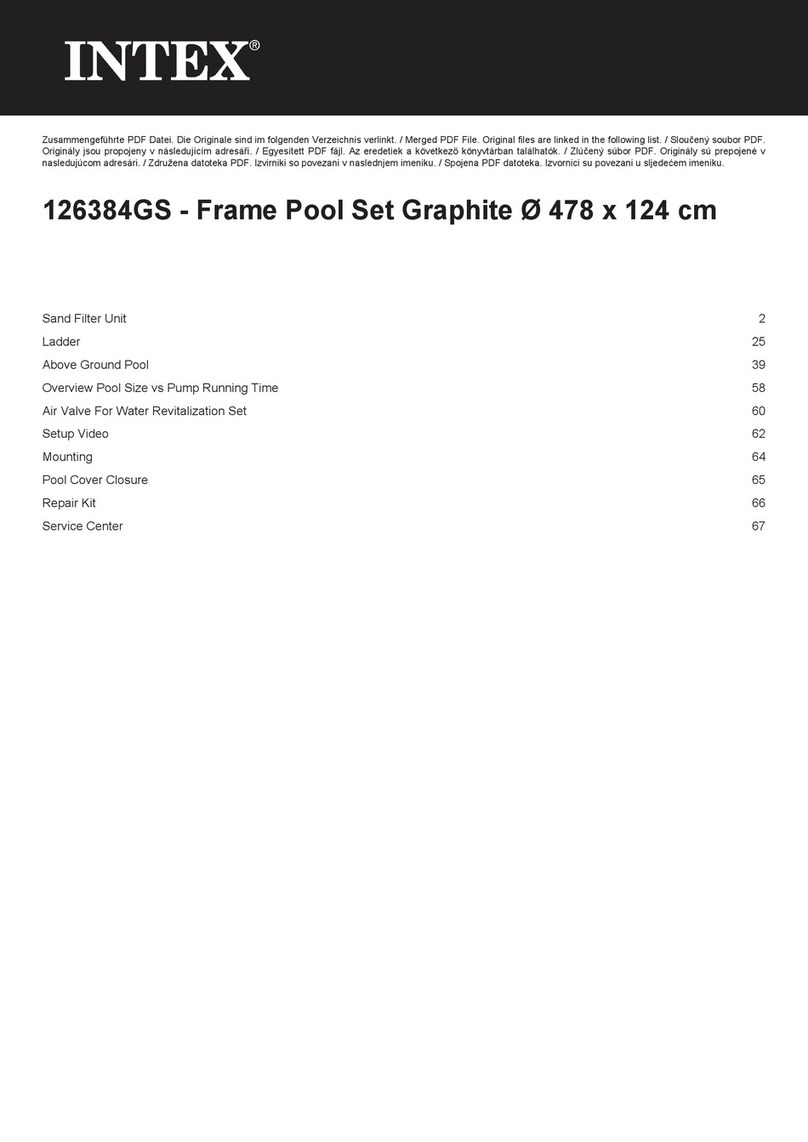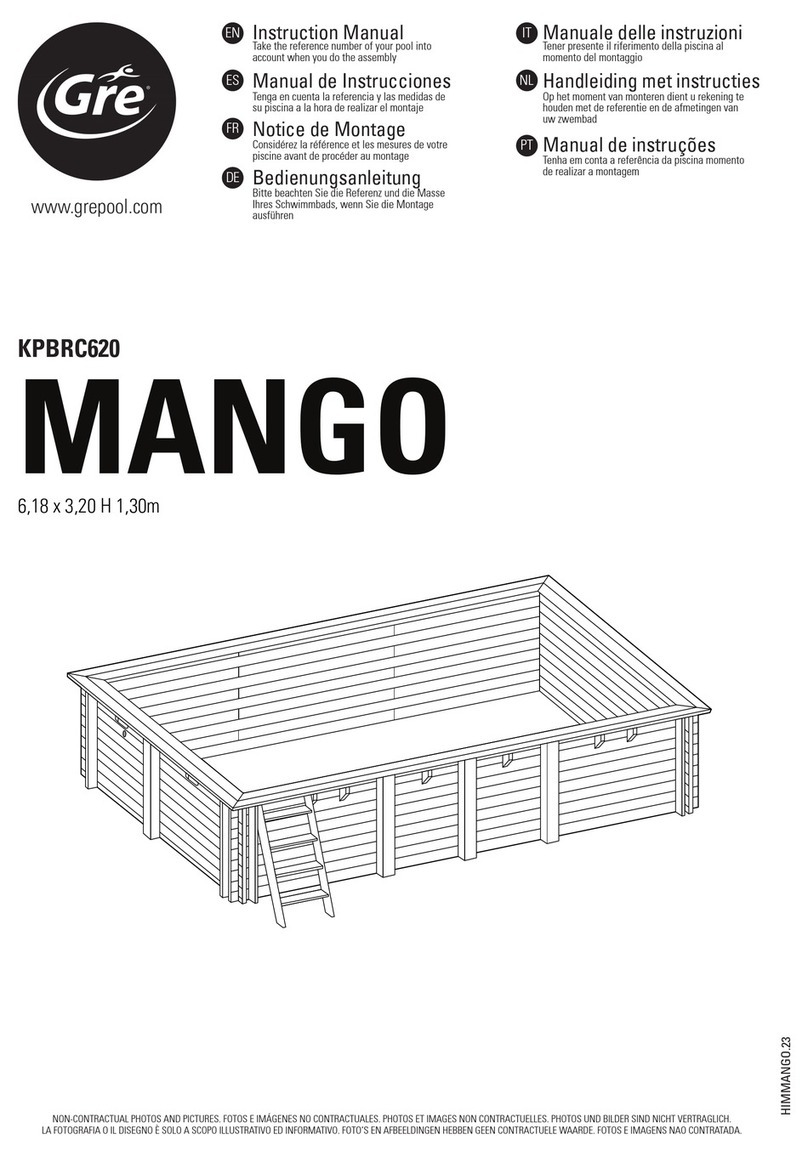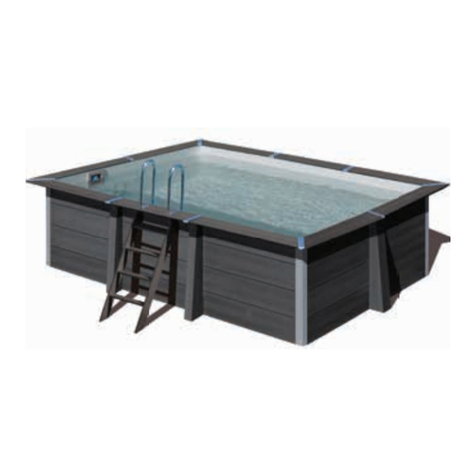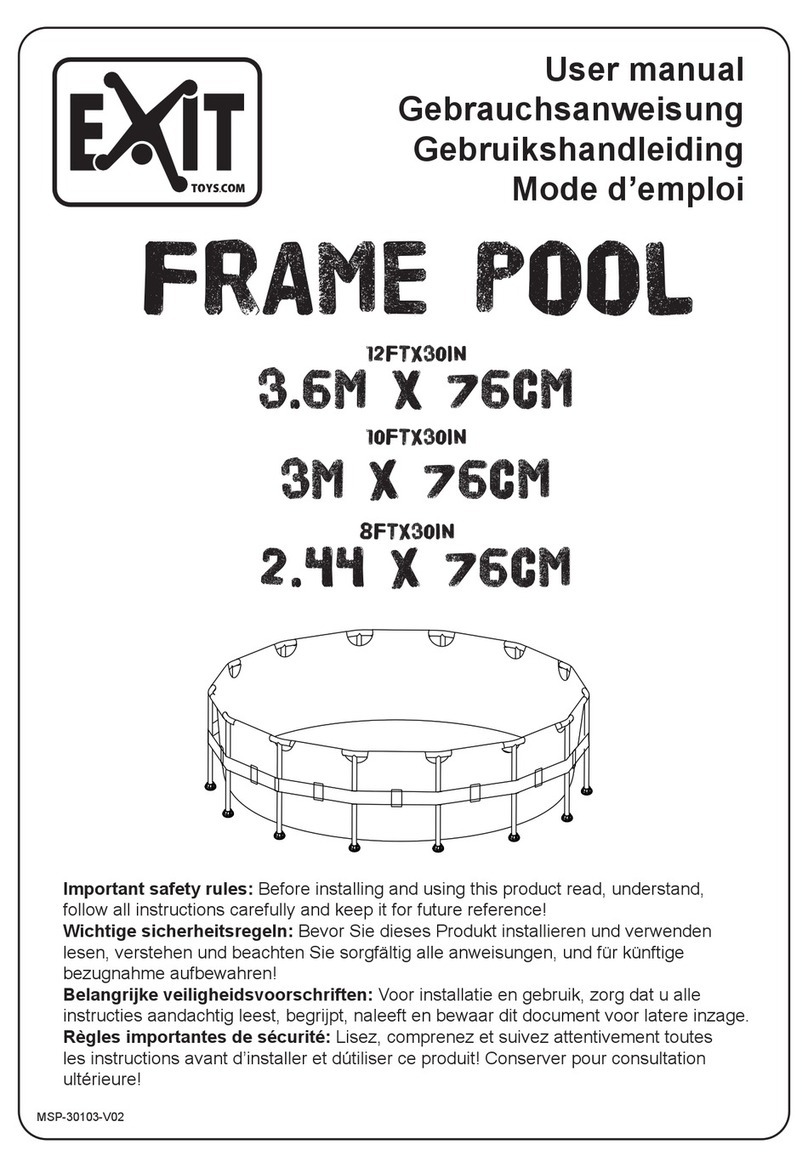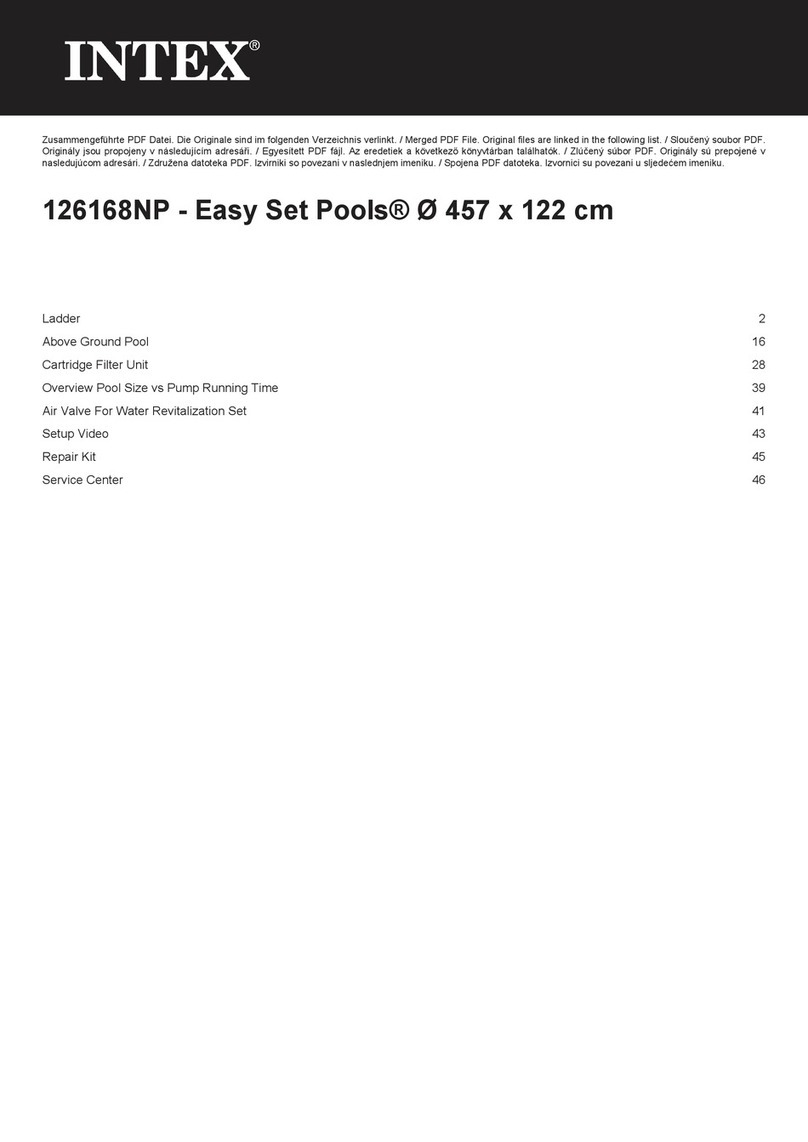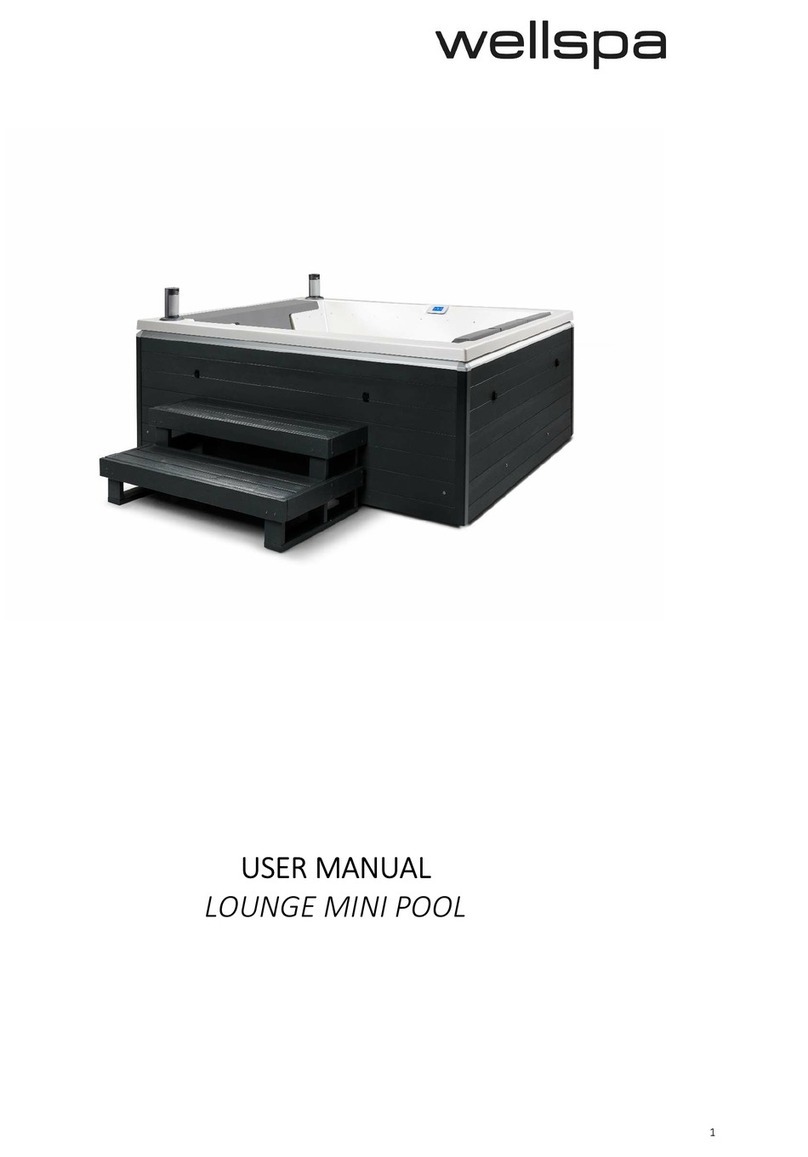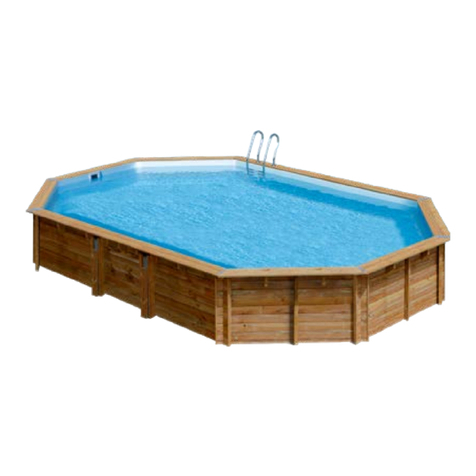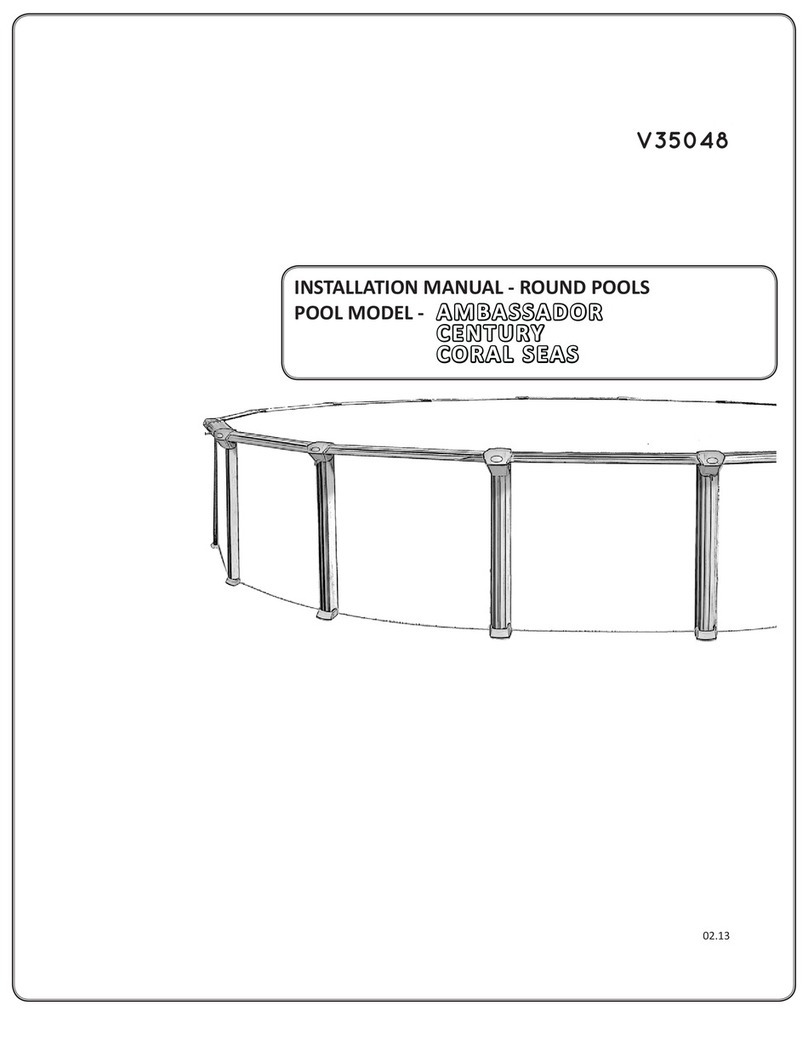
4
À n’utiliser qu’à l’extérieur.
Apprenez à vos enfants à nager.
Ne plongez, sautez ou glissez jamais dans la piscine.
La surveillance d’un adulte est toujours requise.
Les parents devraient apprendre la RCP.
Ne nagez jamais seul.
Faites en sorte que toutes les enceintes, radios et autres
appareils électriques soient toujours loin de la piscine.
Quand vous touchez le filtre, la pompe ou des parties
électriques, vérifiez que le sol sous vos pieds soit bien sec.
Toutes les prises de courant doivent avoir un disjoncteur de
fuite de terre et les raccordements doivent se trouver à au
moins 5 pieds (1,52 m) du périmètre extérieur des parois de la
piscine. À partir de 5-10 pieds (1,52-3,05 m), il doit y avoir soit
un raccordement fixe (boîtier de raccordement) soit un
raccordement avec verrou tournant équipé d’un disjoncteur de
fuite de terre.
Branchez les cordons électriques uniquement sur une prise de
terre à 3 fils.
Tous les objets pouvant se casser doivent rester loin de la zone
de la piscine.
Ne mélangez pas consommation d’alcool et activités dans la
piscine. Ne laissez jamais personne nager, plonger ou glisser
sous l’influence d’alcool ou de drogues.
Il existe un grave risque d’électrocution si vous installez votre
pompe ou votre filtre sur une terrasse. La pompe ou le filtre
pourrait tomber dans l’eau en provoquant une électrocution ou
un choc grave. Ne les installez pas sur une terrasse ou une
autre surface, au-dessus ou légèrement en dessous du rail
supérieur de la piscine.
N’utilisez pas la piscine quand les conditions météorologiques
sont mauvaises, ex. tempêtes électriques, tornades, etc.
Faites attention aux lignes de courant suspendues lorsque vous
videz votre piscine ou que vous utilisez une tige télescopique.
N’autorisez personne à plonger, grimper, s’asseoir ou se tenir
sur les rails supérieurs des piscines.
N’autorisez pas les bousculades et le chahut.
Ne faites pas d’apnée prolongée car vous pourriez vous sentir
mal et vous noyer.
Installez une/des échelle(s) ou des escaliers pour entrer et
sortir de la piscine.
La terrasse doit rester propre et libre d’objets qui pourraient
vous faire trébucher.
Vérifiez régulièrement si la terrasse présente des signes
d’usure ou des boulons dévissés car cela la rendrait
dangereuse.
Expliquez aux utilisateurs de la piscine comme utiliser
correctement la ou les échelles et les escaliers.
Montez ou descendez l’échelle de face.
N'autorisez qu'une seule personne à la fois sur l'échelle.
Contrôlez régulièrement tous les écrous et boulons pour être
certain que l’échelle est bien solide.
Enlevez ou sécurisez l’échelle pour éviter que quelqu’un entre
dans la piscine quand elle n’est pas utilisée.
Veuillez contacter le concessionnaire ou le fabricant de la
piscine pour obtenir des panneaux de sécurité supplémentaires
si cela s’avère nécessaire.
Adressez-vous à un professionnel de piscine certifié pour
l’entretien de la piscine.
Tout équipement raccordé aux systèmes de circulation doit être
positionné de manière à éviter qu’il soit utilisé comme accès à
la piscine par les enfants en bas âge.
L’installation doit être conforme aux codes de l’autorité en
vigueur et peut nécessiter des permis pour la construction, la
plomberie, l’électricité, la délimitation, etc.
La piscine doit être située à une distance minimale de 6 pieds
(1,83 m) de toute prise électrique.
Toutes les prises de 125 volts, 15 et 20 A situées dans un rayon
de 20 pieds (6,0 m) de la piscine doivent être protégées par un
disjoncteur de fuite de terre. La distance de 20 pieds (6 m) est
mesurée en tenant compte de la distance à vol d’oiseau la plus
courte que le cordon suivrait sans traverser un plancher, mur,
plafond, porte, fenêtre ou autre barrière permanente.
Avant d’utiliser la piscine, l’installateur doit apposer tous les
panneaux d’interdiction de plonger et tous les panneaux de
sécurité conformément à la notice d'installation afin qu'ils soient
bien visibles.
Une barrière est nécessaire pour protéger contre une
éventuelle noyade et une quasi-noyade mais les barrières ne
remplacent pas la surveillance constante des enfants.
Il faut préparer une liste des numéros de téléphone de secours,
comme le poste de police le plus proche, les pompiers,
l’ambulance et/ou une unité de sauvetage. Ces numéros
doivent se trouver à côté du téléphone le plus proche de la
piscine.
Les jouets, chaises, tables ou objets similaires sur lesquels un
enfant en bas âge pourrait monter doivent se trouver à au
moins 4 pieds (1219 mm) de la piscine.
Si l’installateur utilise une terrasse, celle-ci doit être conforme à
la norme APSP-8.
Un équipement de sauvetage basique, y compris l’un des
suivants, doit toujours se trouver à portée de main : a. Une tige
légère, résistante et rigide (bâton de berger) mesurant au moins
12 pieds (3,66 m). b. Une corde d’au moins ¼ in. (6 mm) de
diamètre et mesurant 1 fois ½ la largeur maximale de la piscine
ou 50 pieds (15,24 m), en choisissant la mesure la plus petite,
ayant été solidement attachée à une bouée agréée par les
sauveteurs ou des dispositifs de flottaison agréés de même
type.
La couverture de la piscine n’est pas conçue comme barrière
de sécurité.
Veuillez utiliser un éclairage artificiel quand vous utilisez la
piscine la nuit, pour illuminer tous les panneaux de sécurité, les
échelles, les marches, les terrasses et les parcours.
La piscine est susceptible de s'user et de s'abîmer. Si elle n’est
pas entretenue correctement, certains types de détérioration
excessive ou accélérée peuvent porter à une panne de la
structure de la piscine qui pourrait libérer de grandes quantités
d’eau susceptibles de provoquer des blessures ou des dégâts
Il faut toujours pouvoir voir le fond de la piscine du périmètre
extérieur de celle-ci.
L’installateur de la bâche en vinyle doit apposer sur la bâche
d’origine ou celle de rechange, ou sur la structure de la piscine,
tous les panneaux de sécurité conformément aux instructions
du fabricant.
Si vous avez une pompe de filtration, reportez-vous à la notice
d’instructions de la pompe.
L’échelle doit être placée sur une base solide et conformément
au mode d’emploi de la piscine.
Il existe des publications qui décrivent le risque de se noyer et
de rester coincé ainsi que les accidents de plongée.
Des publications sont disponibles au sujet de la sécurité dans
les piscines, notamment les brochures de l’Association des
professionnels de piscines et spas (APSP) intitulées : The
Sensible Way to Enjoy Your Aboveground/Onground Swimming
Pool, Children Aren’t Waterproof, Pool and Spa Emergency
Procedures for Infants and Children, Layers of Protection, et la
toute dernière édition du Code des barrières du modèle
ANSI/APSP-8 pour les piscines privées, les spas et les bains
chauds.
À lire attentivement et à conserver pour
consultation ultérieure.
AVERTISSEMENT
EMPÊCHEZ
LA NOYADE
Surveillez les enfants en tout temps.
NE PAS PLONGER!
Vous risquez des blessures graves.
Eau peu profonde.
AVERTISSEMENT
CHOISISSEZ UN EMPLACEMENT CORRECT
La surface choisie pour installer la piscine doit respecter les caractéristiques techniques suivantes :
1. En raison du poids combiné de l’eau à l’intérieur de la piscine et des usagers de la piscine, il est extrêmement important que la
surface choisie pour installer la piscine soit capable de supporter uniformément le poids total pendant tout le temps où la piscine
sera installée. Lorsque vous choisissez la surface, tenez compte que de l’eau pourrait s’échapper de la piscine pendant l’utilisation
ou en cas de pluie. Si l’eau ramollit la surface, celle-ci pourrait perdre sa capacité de soutenir le poids de la piscine.
2. Nous conseillons de positionner la piscine loin des objets que les enfants pourraient utiliser pour grimper dans la piscine.
3. Positionnez la piscine à proximité d’un système de drainage adéquat pour faire face à un éventuel débordement ou pour vider la
piscine.
4. La surface doit être plane et lisse. Si la surface est inclinée ou irrégulière, la structure de la piscine peut être déséquilibrée. Cette
situation peut endommager les soudures du liner, le haut de la paroi en acier et les plateformes verticales. Dans les cas les plus
extrêmes, la piscine peut s’effondrer, en occasionnant des blessures graves et/ou des dommages aux biens personnels.
5. La surface choisie doit être libérée de tout type d’objet. En raison du poids de l’eau, tout objet situé sous la piscine pourrait
endommager et trouer le fond de la piscine.
6. La surface choisie doit être libérée des plantes agressives et des mauvaises herbes. Ces types de végétation résistante pourraient
pousser à travers la bâche et créer des fuites d’eau. L’herbe ou toute autre végétation qui pourrait provoquer la formation d’odeurs
ou de vase doit être éliminée de l’emplacement choisi pour l’installation.
7. Il ne doit pas y avoir de lignes de haute tension ni d’arbres au-dessus de l’emplacement choisi. Vérifiez que l’emplacement ne
contienne pas de tuyaux, de lignes ou de câbles sous terre, quels qu’ils soient.
8. La position choisie doit être éloignée de l’entrée de la maison. Ne placez aucun équipement ou autre meuble autour de la piscine.
L’eau sortant de la piscine durant l’utilisation ou en raison d’un produit défectueux peut endommager le mobilier à l’intérieur de la
maison ou autour de la piscine.
9. La surface choisie doit être plane et dépourvue de trous qui peuvent endommager le matériau de la bâche.
Suivez les consignes importantes ci-dessus pour choisir la bonne surface et le bon emplacement pour y installer votre piscine. Les
parties endommagées de la piscine, en raison d’une surface d’installation et d’un emplacement ne correspondant pas aux
instructions, ne seront pas considérées comme des vices de fabrication et rendront la garantie caduque et interdiront toute
réclamation.
Surfaces d’installation conseillées : pelouse, terre, béton et toutes les autres surfaces qui respectent les conditions d’installation
ci-dessus.
Surfaces déconseillées : boue, sable, gravier, terrasse en bois, balcon, sortie de garage, plateforme, terre meuble/friable ou autre
surface ne correspondant pas aux conditions d'installation ci-dessus.
Adressez-vous à votre mairie pour connaître les lois en vigueur en matière de clôtures, barrières, éclairage et exigences de sécurité,
et vérifiez que vous respectez bien toutes ces lois.
Si vous avez une pompe de filtration, reportez-vous à la notice d’instructions de la pompe.
L’échelle doit être adaptée à la taille de la piscine et ne doit être utilisée que pour entrer et sortir de la piscine. Il est interdit de
dépasser la charge admissible de l’échelle. Vérifiez régulièrement que l’échelle soit montée correctement.

